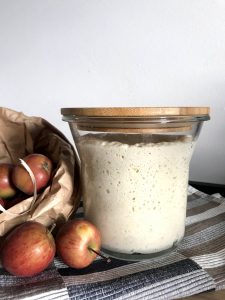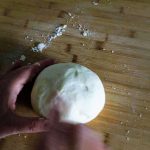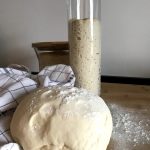Incredible how much an ingredient such as yeast is able to completely change the flavor, texture and also the digestibility of the things where we insert it, foods we love, such as bread, focaccia, panettone. The idea of having to add another commitment in my already busy days, the thought of having to manage not only family and dog but also yeast, noo too much! Laziness and many small excuses kept me tied to the comfortable and versatile sachet.
Then, something came up that pushed me to try: I wanted to make panettone for Christmas. And so here I am, fond of that jar that I store in the refrigerator whose contents give me great satisfaction.
I read and studied and finally started creating my sourdough with only two ingredients… no three, flour, water and a lot of patience! In this project I was accompanied by two great friends with whom every day, connected by video call, we take care of our yeast.
I told you that the first goal was to have the yeast in time to prepare the panettone (several bloggers state that several months are needed to have a yeast “ready” to prepare large leavened products. For my experience it is not necessary so many time). The time it takes to bring the sourdough to the right maturation is about 20 days, but this time will depend on many factors such as the flour used, the temperature of the environment, and still the microorganisms that are present in the air. So don’t worry if your yeast doesn’t follow exactly what we’re going to say below… Maybe it will be more asleep or more sparkling, give him time, care and dedication!
Fundamental is the choice of flour that must be of good quality, preferably of type 0 or 1 better when ground to stone.

First dough: day 1
Our goal is to capture yeasts and bacteria in the air and channel them into our dough, flour and water, allowing them to eat this and reproduce! What proportions to make the impact? I put 50% of the weight of the water flour, yes only flour water.
Knead;
- 100 gr type 1 flour or 0
- 50 gr smooth water
Knead the two ingredients well until you create a compact and smooth ball, then put the dough in a clean jar, cover with a damp towel or kitchen paper stopped by an elastic band and leave to ferment for 24/36 hours at room temperature (the ideal would be at 25°C.). Do not be afraid if passing in front of your jar you will not see any transformation inside it: in this first phase, no particular growth of the dough will be observed, but inside it will develop the first yeasts and bacteria.



Second dough: day 2
After 24-36 hours you will find a ball of cohesive dough, having the same initial volume, or almost, with some bubbles on the surface of the dough. You can already smell the characteristic smell of yeast. The ball will have a hard surface crust that you will have to remove with a knife before starting with the first refreshments. Take the middle part of the yeast. Weigh the sourdough you want to refresh, recommend at least 100 grams, and knead as follows:
- Flour: equal weight of yeast. The flour to be used in this first refreshments should be the same used for the first dough.
- Water: 43% of the weight of Flour
for example, if you want to refresh 100g of sourdough, you will have to knead it with:
- 100 gr flour
- 43 gr cold water
Knead everything, put the dough back in a container by marking the starting level with a marker or placing an elastic band, so you can see the development and cover it as done the previous day. Let it rest for about 48 hours at 25°C. At the end of this period, you can see a slight growth of the dough (about 1 and a half times its initial volume). If that’s not the case, don’t worry, give him some more time.
From this moment on you will see that after each refreshment the yeast will grow more and more after 24 hours, going so far as to double towards the 4.5 day.
Third dough
We must continue to refresh our yeast, feed it as we did the previous day, the only change will be the flour that from now on we will use type 00.So:
- Sourdough taken from the center : 100 gr
- Flour type 00: 100 gr
- Water: 43 ml.
After each refreshment the yeast should be stored in a clean and covered container. It should be maintained at a temperature of 25 degrees. If your kitchen is cooler you can put it in the oven off or have a little more patience to see it rise. Approximately after a week or so it should triple the volume in 24 hours.
When this happens it means that the flora of yeasts and bacteria is almost formed and will now have to stabilize.
We continue to repeat the refreshments daily as indicated above until we see that the volume triples ́in 6/8 hours. At this point our yeast is ready to be used.

Redundancies
What do we do with all the sourdough we don’t need in refreshments? There are many recipes to use it, the most immediate and simple one and spread it with your hands over a lollipop of the oven, add some rosemary, coarse salt and a drizzle of oil. Bake it in a hot oven at 180/200 degrees until it starts to color.. Great with aged cheese and ham!
To know if our sourdough is in shape I refer you to a site that in my opinion is done very well, White yeast!
Conservation
There are various methods to store sourdough, I opted to store it in the refrigerator and refresh it constantly (1 time a week if I do not use it). for other methodologies see Bianco Lievito

